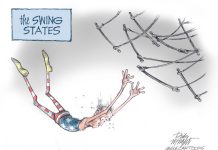Way back in mid-January, as U.S. stocks were sprinting out of the starting blocks, we predicted the U.S. stock market’s steady, uninterrupted run of record highs in 2017 was unlikely to be repeated in 2018.
We cited research from Bespoke Investment Group which indicated 2017 was the first calendar year in history where the S&P 500 saw positive total returns for each month. Not only was the trend straight up in 2017, there were no setbacks along the way. The stock market didn’t suffer a 10 percent pullback and didn’t experience a 5 percent or even 3 percent pullback, either. In fact, the S&P 500 hadn’t had a 3 percent pullback from a high in more than 409 calendar days going back to Nov. 4, 2016, the longest streak on record (going back to 1928).
Further, according to Crandall, Pierce, since 1900, 5 percent corrections have occurred about 3 times a year and 10 percent corrections about once a year, so we stated stocks were long overdue for a pullback. We urged investors to remember 1) corrections are a normal part of the stock landscape and nothing to fear and 2) headlines and talking heads are noise to be ignored.
The S&P 500 reached an all-time high Jan. 26, coinciding with or causing investor sentiment readings to reach a post-crash high and flows into equity funds to surge to $100 billion, the biggest monthly inflow on record, according to The Wall Street Journal.
Virtually on cue, stocks soon encountered violent turbulence, leading to a 10 percent decline over the next 13 days. The plunge featured the headline-grabbing two steepest declines (in points) in the history of the Dow Jones Industrial Average, 1,175.21 (-4.6 percent) on Feb. 5 and 1,032.89 (-4.1 percent) on Feb. 8 (though neither decline ranked in the top 100, in percentage terms).
Corporate earnings and economic data remain solid, so pundits blamed the correction on fears over rising inflation/interest rates, a more “hawkish” Fed and the breakdown of a misused option product used to place leveraged bets on market volatility. Whatever the reason, many investors failed the market test and panicked. Predictably, investor sentiment and equity fund flows immediately turned negative.
As their name implies, “robo-advisers” give computer-generated “advice” for very low fees (as they don’t have to think or eat). Possibly the most important function an investment adviser worth his or her salt is keeping clients from doing things harmful to their own financial well-being during times of market stress. Robo-advisers are a fairly recent “innovation,” so they had never faced a panic situation. The websites of two of the biggest robo-advisers, Wealthfront and Betterment, crashed during the tumult Feb. 5, possibly proving the old adage that you get what you pay for.
According to Bespoke, February marked the first down month for the S&P 500 on a total return basis in 15 months, only the sixth time in history the S&P 500 had gains for 10 or more consecutive months. Past performance is not a guarantee of future results, but in the one-month, six-months and one-year periods following the first down month, the S&P 500 was up in every time, averaging +4.65 percent, +18.18 percent and +25.47 percent, respectively.
As Warren Buffett said, “A climate of fear is your friend when investing; a euphoric world is your enemy.”
Mickey Kim is the chief operating officer and chief compliance officer for Columbus-based investment adviser Kirr Marbach & Co. Kim also writes for the Indianapolis Business Journal. He can be reached at 812-376-9444 or [email protected].




